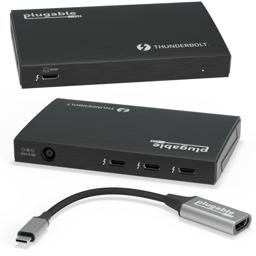The M1 Chip and Compatible Docking Stations
Hi, I'm Gary Zeller and I am the Product Director at Plugable, coming to you today from our studio in Redmond, Washington, to talk about the new 2021 M1 Pro MacBook Pro, a really powerful platform. I’m excited to talk about some of the new capabilities, as well as some of the Plugable products that you can use to help get the most out of it.
So as most of you reading this are aware, last year, Apple introduced the original M1 CPU, an incredibly well-designed chip that's been lauded with almost universal praise for its mix of performance and power efficiency. One of the bits of customer feedback that we did receive was a desire to enable more than a single external display on the M1 platform. And as such, our DisplayLink-based products like our DisplayLink docking stations and USB graphics adapters are a great solution to that configuration request. If you haven't already, please do check out our Triple Monitor on the M1 Mac video.
Features and Ports on the M1 Pro MacBook Pro
This past October, Apple held their Unleashed Event where they unveiled the newest additions to the M1 lineup—the M1 Pro and M1 Max CPUs. We've got the return of the SD card slot, a very sought-after feature from creative professionals, as well as the addition of an HDMI port. One of my personal favorites, the return of the MagSafe connector. Excitingly, for the first time on Apple systems, we've got the appearance of three Thunderbolt 4 ports.
Each of the USB-C ports on the MacBook Pro is capable of providing that full Thunderbolt 4 feature set, which means the ability to connect dual monitors, up to 96W charging power, and gobs of bandwidth for your high-performance USB peripherals—all through a single cable.
Connecting the M1 Pro MackBook Pro to a Thunderbolt docking station (TBT3-UDZ)
So in our setup here, I have the M1 Pro system connected to our flagship TBT3-UDZ Docking Station, which connects to Thunderbolt 4 systems, Thunderbolt 3 systems, and even USB-C systems that don't have Thunderbolt. This offers a wide array of additional connectivity and features. It is one of our most popular docking stations. And certainly, one of the most popular pairings with the new M1 Pro and M1 Max Systems.
When connected, you can attach two additional monitors. HDMI, DisplayPort, or a mix of both. It has an additional seven USB ports in the mix of USB-A and USB-C. It also has gigabit ethernet and a Thunderbolt USB-C cable connection back to the host system.
The TBT3-UDZ is a great choice for creative professionals and power users. It’s what we use internally here on our creative team to create lots of content for YouTube, Amazon, our website, and wherever else you see it.
We have been contending with IC shortages for the past year. If you find that the TBT3-UDZ is not in stock currently, sign up here to be notified when it is available again.
As you can see in the video, we've got two monitors connected to our TBT3-UDZ, and by extension, our M1 Pro MacBook Pro system. Both monitors are operating at full native resolution and performance. It is running at the full native performance of the GPU in the system so it’s capable of doing anything from video rendering to playing back protected content on Netflix, Apple TV, or your platform of choice. And once you are done for the day, or want to move locations, switch cubicles, switch desks, move to another room in your house, all you need to do is unplug that single cable and off you go.
Connecting the M1 Pro MackBook Pro to a Thunderbolt Hub (TBT4-HUB3C)
So now that we've taken a look at what's possible with a Thunderbolt Docking Station connected to the M1 Pro, I thought it'd be cool to take a look at our Thunderbolt 4 hub, the TBT4-HUB3C. We’ll connect an HDMI monitor to our Thunderbolt hub with the included HDMI to USB-C adapter and then to the MacBook Pro. Now, not only will we have display output, but we’ll also be charging the laptop based on what this hub is capable of—in this case, it's a 60W charging hub.
Next, I'm going to connect a couple of our popular high-performance storage drives. These are Thunderbolt drives that have NVME SSDs inside. I am going to plug in these Thunderbolt SSDs to make a little mobile editing bay with single cable conductivity to super-high bandwidth, and high-performance storage. Now we have two drives connected, a single display connected and we are charging everything over Thunderbolt 4. That gives us a 40 gigabit per second high-performance connection between the hub and the M1 MacBook Pro for flexibility and incredibly high performance regardless of the workload you throw at it.
We have USB-C and Thunderbolt products that will meet almost any configuration needed for these powerful new systems. If you have any questions, don't hesitate to reach out to our US-based support team at support@Plugable.com.





Loading Comments